Wettability Characteristics of Mixed Sedimentary Shale Reservoirs in Saline Lacustrine Basins and Their Impacts on Shale Oil Energy Replenishment: Insights from Alternating Imbibition Experiments
Abstract
1. Introduction
2. Materials and Methods
2.1. Geological Features
2.2. Sample Collection and Characteristics
2.3. Experimental Method and Procedure
3. Results
3.1. Layer Characteristics and Lithologic Division
3.2. Storage Space Type
3.3. Alternating Saturation
3.4. Contact Angle Result
4. Discussion
4.1. Wetting Characteristics
4.2. Analysis on Factors Influencing Wettability of Mixed Rocks
4.2.1. Material Composition
4.2.2. Lamination Type
4.2.3. Pore Structure
4.2.4. Increase Recovery Rate
5. Conclusions
Author Contributions
Funding
Data Availability Statement
Acknowledgments
Conflicts of Interest
References
- Zou, C.; Zhang, G.; Yang, Z.; Tao, S.; Hou, L.; Zhu, R.; Yuan, X.; Ran, Q.; Li, D.; Wang, Z. Concepts, Characteristics, Potential and Technology of Unconventional Hydrocarbons: On Unconventional Petroleum Geology. Pet. Explor. Dev. 2013, 40, 413–428. [Google Scholar] [CrossRef]
- Jia, C.; Zheng, M.; Zhang, Y. Unconventional Hydrocarbon Resources in China and the Prospect of Exploration and Development. Pet. Explor. Dev. 2012, 39, 139–146. [Google Scholar] [CrossRef]
- Tang, Y.; He, W.; Jiang, Y.; Fei, L.; Shan, X.; Zhao, Y.; Zheng, M.; Cao, J.; Qing, Z.; Yang, S.; et al. Enrichment Conditions and Exploration Direction of Permian Saline Lacustrine Shale Oil and Gas in Junggar Basin. Shiyou Xuebao Acta Pet. Sin. 2023, 44, 125–143. [Google Scholar] [CrossRef]
- Li, Q. Wettability and Its Major Determinants of Shale Reservoirs in the Shahejie Formation, Dongying Sag, Bohai Bay Basin. Oil Gas Geol. 2024, 45, 1142–1154. [Google Scholar] [CrossRef]
- Feng, C.; Fan, H.; Shi, Y.; Chen, X.; Li, G.; Mao, Z. Prediction for the Formation Water Salinity in Low-Permeability Reservoirs with Complex Wettability: A Case Study of the Triassic Chang 81 Member, Longdong Area, Ordos Basin. Oil Gas Geol. 2020, 41, 442–448. [Google Scholar] [CrossRef]
- Li, H.; Wang, B.; Lu, J.; Lu, K.; Wang, M.; Zhou, Y.; Zhao, L. Geological Characteristics and Exploration Prospects of Paleogene Continental Shale Oil Accumulation in Dongpu Sag, Bohai Bay Basin. Zhongguo Shiyou Daxue Xuebao Ziran Kexue Ban J. China Univ. Pet. Ed. Nat. Sci. 2021, 45, 33–41. [Google Scholar] [CrossRef]
- Shi, K.; Chen, J.; Pang, X.; Jiang, F.; Pang, H.; Hui, S.; Ma, K.; Cong, Q. A Review of Methods for Measuring the Wettability of Reservoir Minerals. Spec. Oil Gas Reserv. 2024, 31, 1–9. [Google Scholar]
- Dezellus, O.; Hodaj, F.; Rado, C.; Barbier, J.N.; Eustathopoulos, N. Spreading of Cu–Si Alloys on Oxidized SiC in Vacuum: Experimental Results and Modelling. Acta Mater. 2002, 50, 979–991. [Google Scholar] [CrossRef]
- Mirzaei-Paiaman, A.; Ghanbarian, B. A Note on Dynamic Rock Typing and TEM-Function for Grouping, Averaging and Assigning Relative Permeability Data to Reservoir Simulation Models. J. Nat. Gas Sci. Eng. 2021, 87, 103789. [Google Scholar] [CrossRef]
- Donaldson, E.C.; Thomas, R.D.; Lorenz, P.B. Wettability Determination and Its Effect on Recovery Efficiency. Soc. Pet. Eng. J. 1969, 9, 13–20. [Google Scholar] [CrossRef]
- Chen, R.; Qu, Z.; Zhao, Y. Wettability and Its Effect on Oil Recovery; China Offshore Oil Gas: Singapore, 2001. [Google Scholar]
- Yu, Y.; Liu, H.; Liang, D.; Zhang, Y. A Versatile Lattice Boltzmann Model for Immiscible Ternary Fluid Flows. Phys. Fluids 2019, 31, 012108. [Google Scholar] [CrossRef]
- Chen, Y.; Ubaidah, A.; Elakneswaran, Y.; Niasar, V.J.; Xie, Q. Detecting pH and Ca2+ Increase during Low Salinity Waterflooding in Carbonate Reservoirs: Implications for Wettability Alteration Process. J. Mol. Liq. 2020, 317, 114003. [Google Scholar] [CrossRef]
- Ivanova, A.; Mitiurev, N.; Cheremisin, A.; Orekhov, A.; Kamyshinsky, R.; Vasiliev, A. Characterization of Organic Layer in Oil Carbonate Reservoir Rocks and Its Effect on Microscale Wetting Properties. Sci. Rep. 2019, 9, 10667. [Google Scholar] [CrossRef]
- Uzun, O.; Kazemi, H.; Sonnenberg, S.A. Wettability in Niobrara, Codell, Eagle Ford, Bakken, and Wolfcamp Formations: For EOR and CCUS Applications. In Proceedings of the 2022 SPE/AAPG/SEG Unconventional Resources Technology Conference, URTEC 2022, Houston, TX, USA, 20–22 June 2022. [Google Scholar]
- Alvarez, J.O.; Schechter, D.S. Wettability, Oil and Rock Characterization of the Most Important Unconventional Liquid Reservoirs in the United States and the Impact on Oil Recovery. In Proceedings of the 4th Unconventional Resources Technology Conference, American Association of Petroleum Geologists, San Antonio, TX, USA, 1–3 August 2016. [Google Scholar]
- Araujo De Itriago, Y.C.; Albrecht, J.; Möeller, A.; Dallmann, G. A Different Approach to Evaluate Wettability in Shales. In Proceedings of the Abu Dhabi International Petroleum Exhibition & Conference, Abu Dhabi, United Arab Emirates, 13 November 2017. [Google Scholar]
- Saputra, I.W.R.; Adebisi, O.; Ladan, E.B.; Bagareddy, A.; Sarmah, A.; Schechter, D.S. The Influence of Oil Composition, Rock Mineralogy, Aging Time, and Brine Pre-Soak on Shale Wettability. ACS Omega 2022, 7, 85–100. [Google Scholar] [CrossRef] [PubMed]
- Yassin, M.R.; Begum, M.; Dehghanpour, H. Organic Shale Wettability and Its Relationship to Other Petrophysical Properties: A Duvernay Case Study. Int. J. Coal Geol. 2017, 169, 74–91. [Google Scholar] [CrossRef]
- Huo, X.; Sun, L.; Li, B.; Feng, C.; Zhang, Z. Influencing Factors and Research Progress of Shale Reservoir Wettability. Appl. Chem. Ind. 2023, 52, 3354–3358, 3364. [Google Scholar] [CrossRef]
- Xu, D.; Li, Y.; Deng, Y.; Peng, S.; Lei, X.; Liu, H.; Liu, D. Investigation on Wettability Characteristics and Influencing Factors of Lucaogou Shale Oil Formation in Jimusar. Sci. Technol. Eng. 2023, 23, 12038–12044. [Google Scholar]
- Xiang, L.; Li, C.; Li, H.; Meng, J.; Huang, D. Surface Wettability of Ca-montmorillonite Based on Molecular Dynamics Simulation. Sci. Technol. Eng. 2022, 22, 15952–15958. [Google Scholar]
- Chai, R.; Liu, Y.; Wang, J.; Xin, J.; Pi, J.; Li, C. Wettability of Calcite and Dolomite by Molecular Dynamics Simulation. Comput. Phys. 2019, 36, 474–482. [Google Scholar] [CrossRef]
- Liu, J.; Chen, Y.; Zhang, T.; Sun, S. Wettability Analysis in Shale Organic Pores at the Nanoscale. Acta Mech. Sin. 2023, 55, 1800–1808. [Google Scholar]
- Xi, K.; Zhang, Y.; Cao, Y.; Gong, J.; Li, K.; Lin, M. Control of Micro-Wettability of Pore-Throat on Shale Oil Occurrence: A Case Study of Laminated Shale of Permian Lucaogou Formation in Jimusar Sag, Junggar Basin, NW China. Pet. Explor. Dev. 2023, 50, 297–308. [Google Scholar] [CrossRef]
- Zheng, G.; Gao, Z.; Huang, L.; Jiang, Z.; He, W.; Chang, J.; Duan, L.; Wei, W.; Wang, Z. Wettability of the Permian Fengcheng Formation Shale in the Mahu Sag, Junggar Basin, and its main control factors. Oil Gas Geol. 2022, 43, 1206–1220. [Google Scholar]
- Zeng, J.; Yi, M.; Nie, J.; Zhang, T.; Yang, Y.; Li, X. Quantitative Characterization of Shale Wettability in Southeastern Chongqing Area. Unconv. Oil Gas 2021, 8, 90–94. [Google Scholar] [CrossRef]
- Liu, X. Main Factors Controlling the Wettability of Shales. Master’s Thesis, China University of Geosciences, Beijing, China, 2018. Available online: https://link-cnki-net-s.webvpn.upc.edu.cn/doi/10.27493/d.cnki.gzdzy.2018.000227 (accessed on 20 May 2025). [CrossRef]
- Ivanova, A.A.; Mitiurev, N.A.; Shilobreeva, S.N.; Cheremisin, A.N. Experimental Methods for Studying the Wetting Properties of Oil Reservoirs: A Review. Izv. Phys. Solid Earth 2019, 55, 496–508. [Google Scholar] [CrossRef]
- Ye, H.; Ning, Z.; Wang, Q.; Cheng, Z.; Huang, L.; Mu, D. Spontaneous Imbibition Experiment and Wettability Study of Shale Reservoir. Fault Block Oil Gas Field 2019, 26, 84–87. [Google Scholar]
- Bondarenko, A.; Islamov, S.; Ignatyev, K.; Mardashov, D.; Saint Petersburg Mining University. Saint Petersburg Mining University Laboratory Studies of Polymer Compositions for Well-Kill Under Increased Fracturing. Perm J. Pet. Min. Eng. 2020, 20, 37–48. [Google Scholar] [CrossRef]
- Belousov, A.; Lushpeev, V.; Sokolov, A.; Sultanbekov, R.; Tyan, Y.; Ovchinnikov, E.; Shvets, A.; Bushuev, V.; Islamov, S. Experimental Research of the Possibility of Applying the Hartmann–Sprenger Effect to Regulate the Pressure of Natural Gas in Non-Stationary Conditions. Processes 2025, 13, 1189. [Google Scholar] [CrossRef]
- Wang, J.; Zhang, G.; Zhuang, X.; Gong, Y.; Zhang, Y.; Qu, Y.; Xue, Y.; Cheng, S. Research Progress and Potential Directions of Oil and Gas Exploration in Key Areas of Junggar Basin. Oil Gas Geol. Recovery 2024, 31, 24–41. [Google Scholar] [CrossRef]
- Sun, J.; Yang, Z.; Liu, X.; Xiong, S. Review of Application of Nuclear Magnetic Resonance Technology in Wettability Evaluation of Oil and Gas Reservoirs. Sci. Technol. Rev. 2012, 30, 65–71. [Google Scholar]
- He, H.; Fan, T.; Guo, X.; Yang, T.; Zheng, M.; Huang, F.; Gao, Y. PetroChina: Major Achievements in Oil and Gas Exploration During the 13th Five-Year Plan Period and Development Strategy for the 14th Five-Year Plan. China Pet. Explor. 2021, 26, 17–30. [Google Scholar]
- He, D.; Ma, Y.; Liu, B.; Cai, X.; Zhang, Y.; Zhang, J. Main Progress and Scientific Problems of Deep Exploration in Oil and Gas-Bearing Basins in China. Earth Sci. Front. 2019, 26, 1–12. [Google Scholar] [CrossRef]
- Zheng, M.; Fan, X.; He, W.; Yang, T.; Tang, Y.; Ding, J.; Wu, H.; Chen, L.; Guo, J. Superimposed Evolution of Deep Geological Structure and Hydrocarbon Accumulation in Junggar Basin. Earth Sci. Front. 2019, 26, 22–32. [Google Scholar] [CrossRef]
- He, D.; Zhang, L.; Wu, S.; Li, D.; Zhen, Y. Tectonic Evolution Stages and Features of the Junggar Basin. Oil Gas Geol. 2018, 39, 845–861. [Google Scholar]
- Lian, Z.; Chang, Z.; Li, L.; Lai, J.; Peng, L.; Liu, R. Hydrocarbon Accumulation Characteristics and Exploration Potential of Permian Volcanic Rocks in Madong Area. Oil Gas Reserv. 2022, 29, 57–65. [Google Scholar]
- Zhang, G.; Wang, Y. Tectonic-Sedimentary Pattern and Petroleum Geological Significance of Early Permian in Junggar Basin. Oil Gas Geol. Recovery 2023, 30, 35–48. [Google Scholar] [CrossRef]
- Kang, J.; Wang, J.; Ma, Q.; Li, C.; Chen, X. Fine-Grained Lacustrine Bottom Fan Sediments of Lucaogou Formation in Jimsar Sag, Junggar Basin and Their Significance for Shale Oil Reservoir. Bull. Geol. Sci. Technol. 2023, 42, 82–93. [Google Scholar] [CrossRef]
- Gong, D.; Liu, H.; Yang, H.; Li, Z.; Wang, R.; Wu, W. Gas Generation Potential of Fengcheng Formation Source Rocks and Exploration Fields in Junggar Basin. Xinjiang Pet. Geol. 2022, 43, 674–683. [Google Scholar]
- Zhang, Y.; Cao, J.; Hu, W. Timing of Petroleum Accumulation and the Division of Reservoir-Forming Assemblages, Junggar Basin, NW China. Pet. Explor. Dev. 2010, 37, 257–262. [Google Scholar] [CrossRef]
- SY/T 6103-2019; Determination of Rock Pore Structure Characteristics—Image Analysis Method. National Energy Administration: Beijing, China, 2019.
- Xiao, W.; Yang, Y.; Huang, C.; Xie, Q.; Chen, X.; Cao, R.; Zheng, L.; Ren, J. Influence of Shale Oil Wettability and Its Effect on Crude Oil Mobilization Characteristics Based on Nuclear Magnetic Resonance Technology. Oil Gas Geol. Recovery 2023, 30, 112–121. [Google Scholar] [CrossRef]
- Wang, X.; Li, S.; Liu, Y.; Zhang, Y.; Jiang, L.; Song, Y. A Review of Wettability Measurement of the Reservoir Rock in CO2 Geological Storage. J. Univ. Shanghai Sci. Technol. 2023, 45, 205–219, 290. [Google Scholar]
- Fan, Y.; Chen, L.; Liu, K.; Yu, L.; Liu, J. Effects of Wettability and Pore Water Occurrence of Gas Storage Space of Shale Reservoirs. J. Cent. S. Univ. Sci. Technol. 2022, 53, 3575–3589. [Google Scholar]
- Varjani, S.J. Microbial Degradation of Petroleum Hydrocarbons. Bioresour. Technol. 2017, 223, 277–286. [Google Scholar] [CrossRef]
- Atlas, R.M.; Hazen, T.C. Oil Biodegradation and Bioremediation: A Tale of the Two Worst Spills in U.S. History. Environ. Sci. Technol. 2011, 45, 6709–6715. [Google Scholar] [CrossRef]
- Liu, F.; Wang, D.; Li, Y.; Song, K.; Wei, C.; Qi, X. Mechanism of Enhanced Oil Recovery by Wettability Control-Based Low Salinity Water Flooding in Carbonate Reservoir. Pet. Sci. Bull. 2025, 10, 206–218. [Google Scholar]
- Dong, X.; Wang, W.; Zhang, Y.; Fang, Y.; Yang, Z. Evaluation Experiment of Natural Caco3 Nanoparticles Changing Carbonate Rock Wettability. Pet. Geol. Dev. Daqing 2025, 44, 85–92. [Google Scholar] [CrossRef]
- Arsalan, N.; Palayangoda, S.S.; Burnett, D.J.; Buiting, J.J.; Nguyen, Q.P. Surface Energy Characterization of Sandstone Rocks. J. Phys. Chem. Solids 2013, 74, 1069–1077. [Google Scholar] [CrossRef]
- Wang, X.; Chen, J.; Ren, D. Research Progress and Prospect of Pore Structure Characterization and Seepage Law of Continental Shale Oil Reservoirs. Oil Gas Reservoir Eval. Dev. 2023, 13, 23–30. [Google Scholar] [CrossRef]
- Pu, Y.; Yang, E.; Du, Q. Effect of Mixed Wettability of Tight Reservoirs on the Pore Scale Imbibition Law. J. Northeast Pet. Univ. 2024, 48, 86–95+11. [Google Scholar]

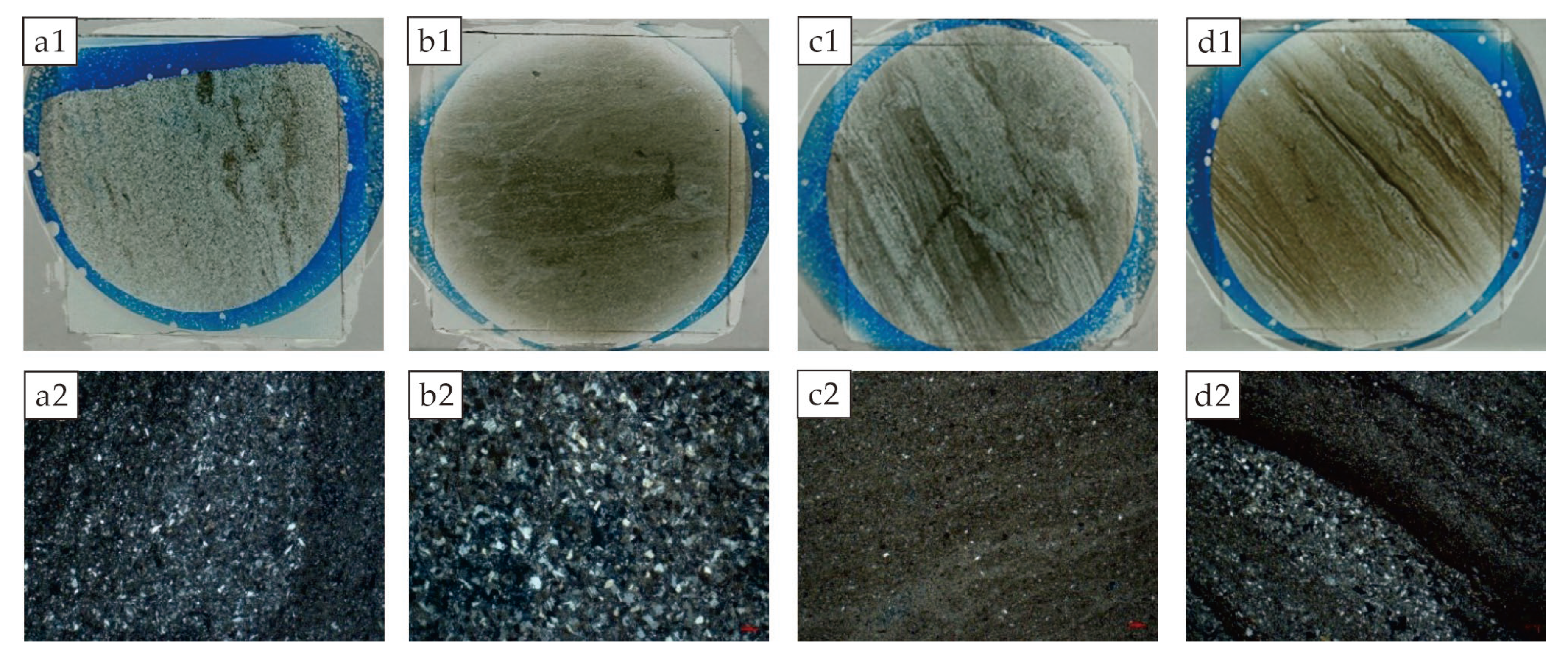

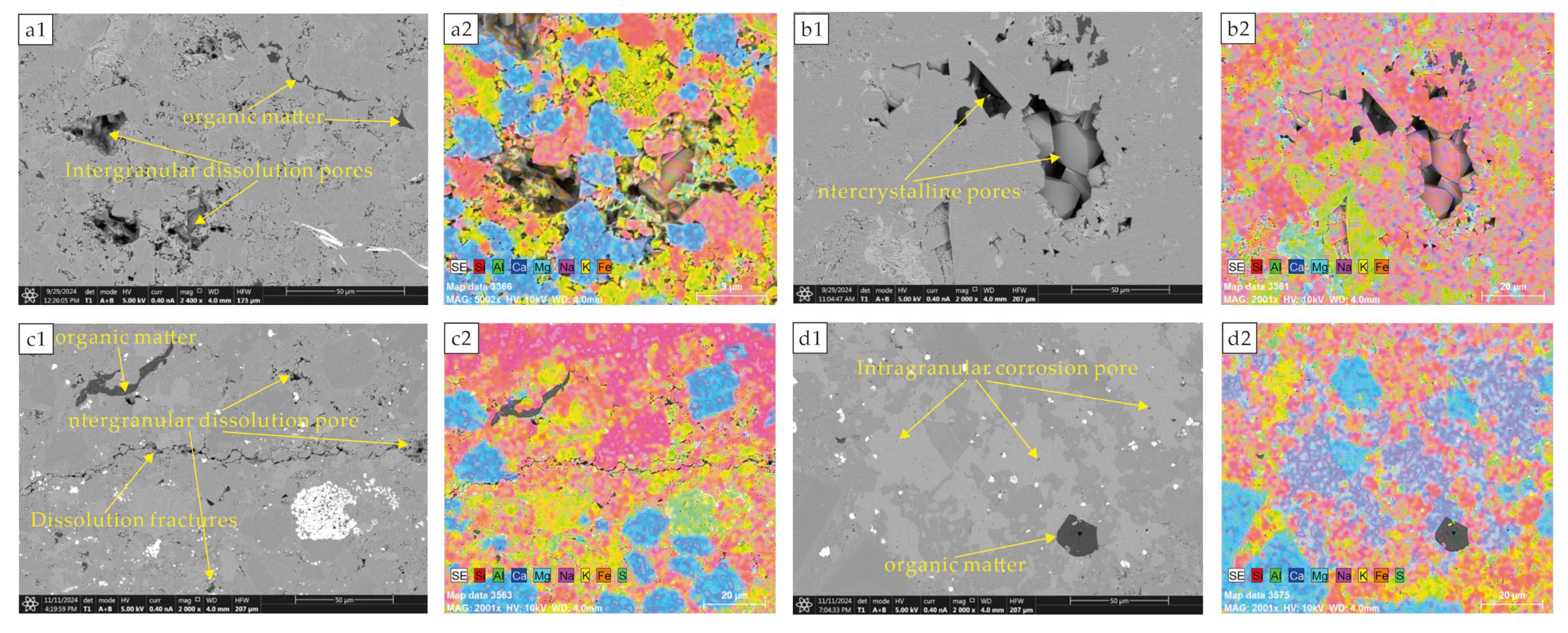
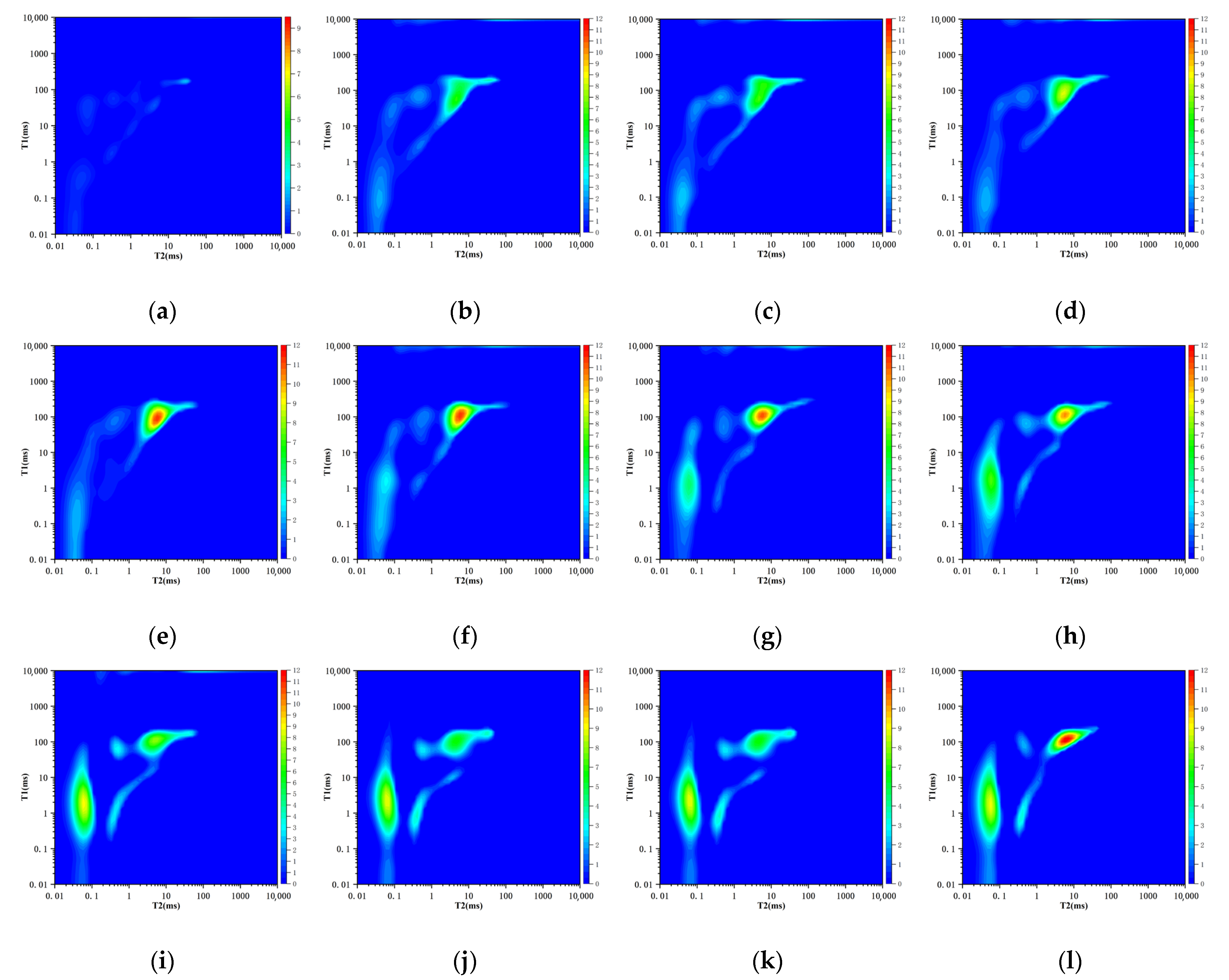


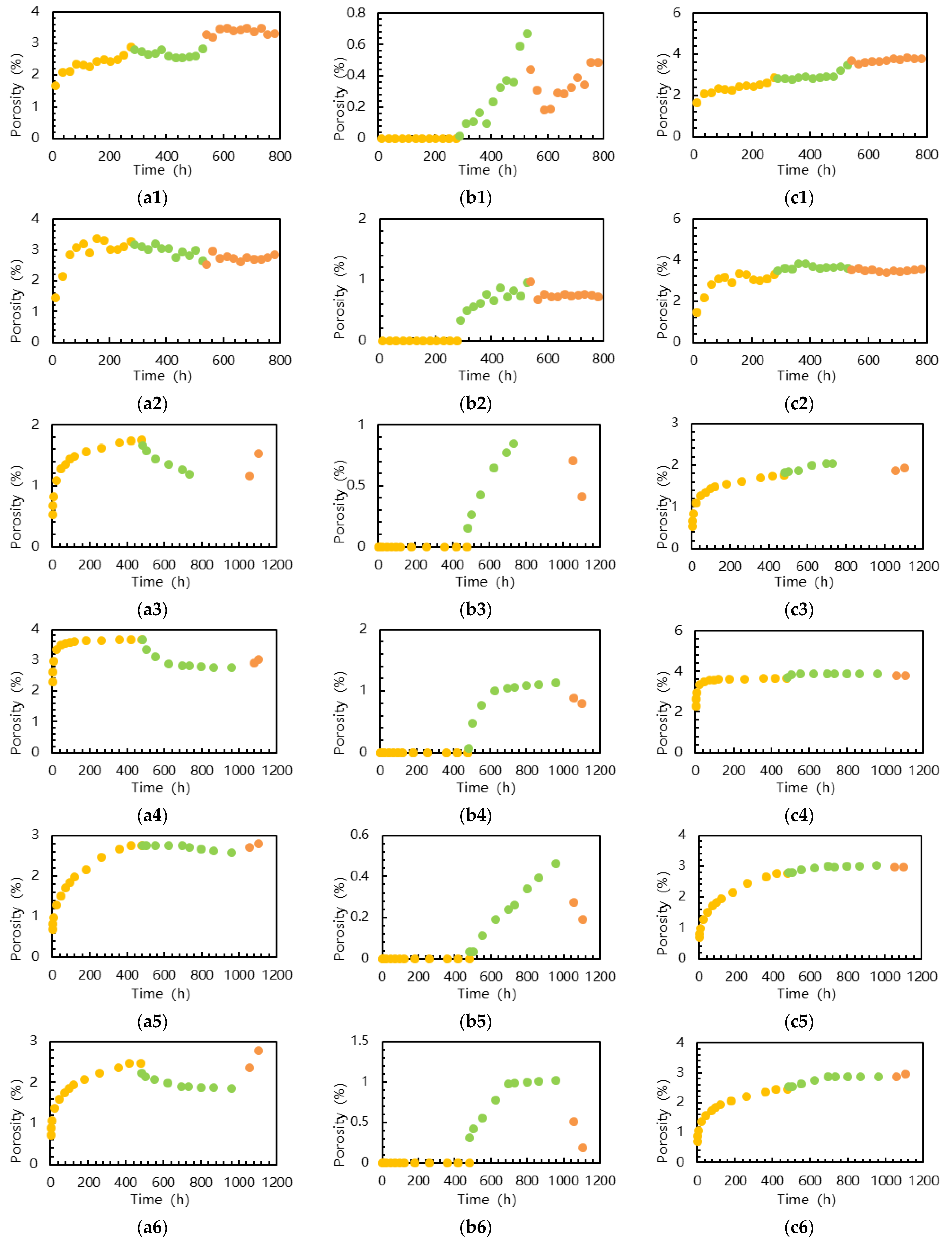
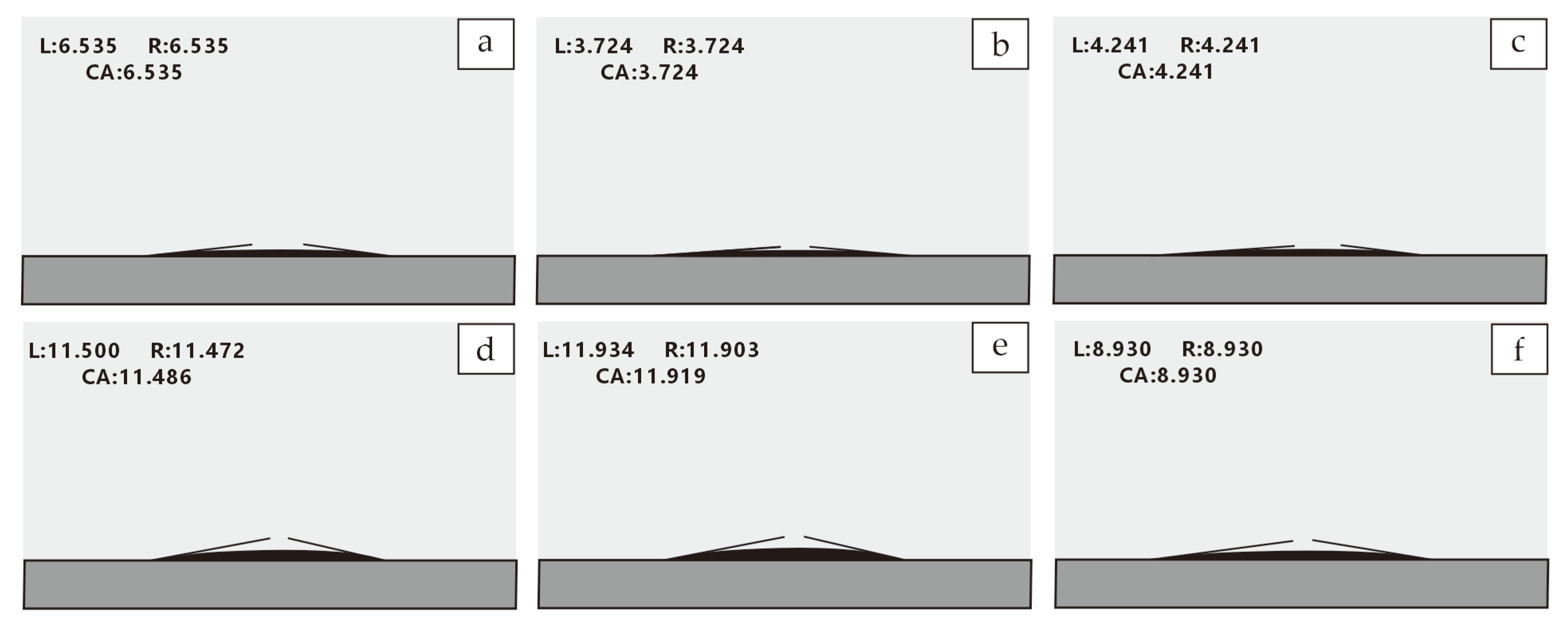
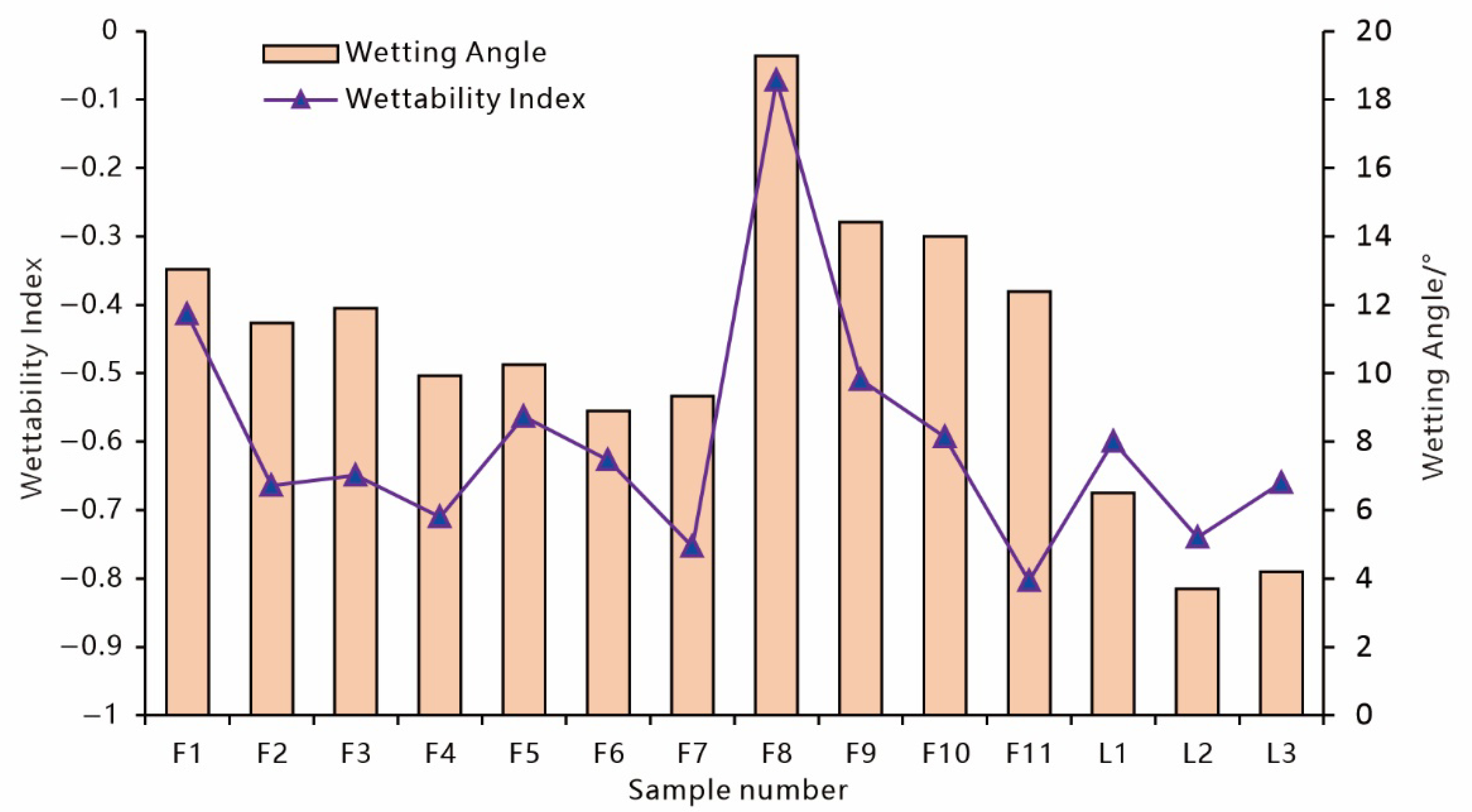

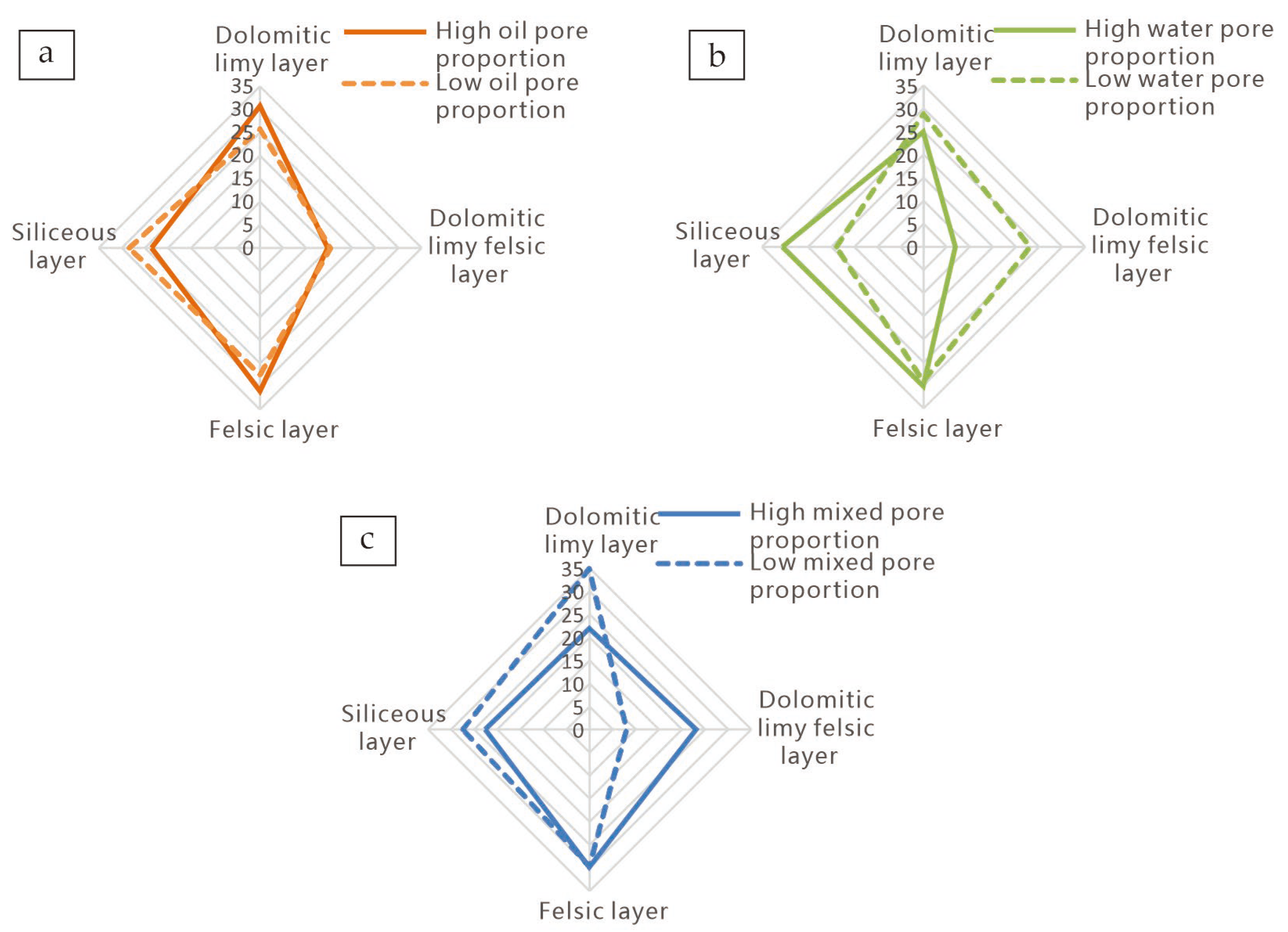

| Sample Number | Depth | TOC/% | Mineral Content/% | |||||||
|---|---|---|---|---|---|---|---|---|---|---|
| Quartz | Potassium Feldspar | Plagioclase | Calcite | Dolomite | Pyrite | Ulexite | Clay Minerals | |||
| L1 | 4137.93 | 0.46 | 21.4 | 1.7 | 42.4 | / | 32.6 | / | / | 0.9 |
| L2 | 4241.40 | 1.57 | 29.8 | 3.7 | 25.8 | 0.4 | 37.9 | / | / | 2.4 |
| L3 | 4234.30 | 2.29 | 30.5 | 11.0 | 29.7 | 0.7 | 24.7 | / | / | 3.4 |
| L4 | 4248.15 | 0.95 | 52.7 | 32.6 | 2.7 | 8.7 | 2.9 | / | / | 0.4 |
| L5 | 4375.98 | 0.34 | 18.7 | 3.7 | 17.2 | 49.2 | 2.4 | / | / | 8.0 |
| L6 | 4123.79 | 0.19 | 43.2 | 2.2 | 40.0 | 2.0 | 4.7 | / | / | 2.6 |
| L7 | 4270.54 | 1.09 | 21.7 | 5.0 | 16.1 | 0.4 | 45.9 | / | / | 10.9 |
| F1 | 4920.80 | 0.84 | 17.1 | 6.3 | 14.3 | 2.0 | 8.9 | 4.2 | 42.5 | 4.7 |
| F2 | 4943.68 | 1.31 | 14.0 | 2.0 | 24.9 | 48.6 | 3.7 | 2.8 | / | 4.0 |
| F3 | 4880.85 | 0.56 | 41.4 | 5.4 | 17.3 | 1.3 | 26.1 | 3.4 | / | 5.1 |
| F4 | 4886.16 | 1.64 | 48.7 | 3.6 | 28.2 | 4.5 | 5.1 | 6.2 | / | 3.7 |
| F5 | 4932.74 | 0.60 | 18.0 | 4.5 | 24.8 | 21.4 | 18.6 | 2.9 | 5.7 | 4.1 |
| F6 | 4950.36 | 0.56 | 0.8 | 6.1 | 11.8 | 60.2 | 7.1 | 3.0 | 9.3 | 1.7 |
| F7 | 4958.97 | 0.49 | 11.8 | 10.1 | 45.3 | 4.2 | 14.6 | 5.3 | 6.9 | 1.8 |
| F8 | 4970.34 | 0.98 | 35.7 | 6.7 | 36.0 | 1.0 | 11.5 | 6.0 | / | 3.1 |
| F9 | 4907.85 | 1.16 | 57.9 | 3.6 | 20.8 | 1.7 | 6.1 | 4.1 | / | 5.8 |
| F10 | 4938.45 | 1.27 | 58.4 | 0.8 | 4.2 | 24.6 | 8.3 | 1.4 | / | 2.3 |
| F11 | 4961.19 | 0.98 | 61.0 | 5.7 | 12.2 | 6.5 | 6.2 | 4.1 | / | 4.3 |
| Stratigraphy | Lithology | Number | Depth/m | Porosity/% | Helium Porosity/% | Wettability Index | |||
|---|---|---|---|---|---|---|---|---|---|
| Mixed Porosity | Water Porosity | Oil Porosity | Total Porosity | ||||||
| Jimsar Depression Lucaogou Formation | Dolomitic Siltstone | L1 | 4137.93 | 0.05 | 0.62 | 3.13 | 3.80 | 7.01 | −0.66 |
| L2 | 4241.40 | 0.64 | 0.31 | 2.61 | 3.57 | 11.44 | −0.64 | ||
| L3 | 4234.30 | 0.20 | 0.41 | 1.96 | 2.57 | 5.27 | −0.60 | ||
| Siltstone | L4 | 4248.15 | 0.06 | 0.89 | 6.21 | 7.16 | 12.80 | −0.74 | |
| L5 | 4375.98 | 0.18 | 0.46 | 2.21 | 2.85 | 8.49 | −0.62 | ||
| L6 | 4123.79 | 0.75 | 1.27 | 5.70 | 7.71 | 8.60 | −0.57 | ||
| Silty dolomite | L7 | 4270.54 | 0.16 | 1.36 | 4.93 | 6.45 | 6.62 | −0.55 | |
| Mahu Depression Fengcheng Formation | Dolomitic limy Shale | F1 | 4920.80 | 0.56 | 0.29 | 1.09 | 1.94 | 2.27 | −0.41 |
| F2 | 4943.68 | 0.04 | 0.18 | 0.97 | 1.19 | 1.78 | −0.66 | ||
| Dolomitic limy felsic Shale | F3 | 4880.85 | 0.93 | 0.21 | 2.68 | 3.81 | 4.27 | −0.65 | |
| F4 | 4886.16 | 0.50 | 0.12 | 1.94 | 2.56 | 2.25 | −0.71 | ||
| Felsic Shale | F5 | 4932.74 | 0.10 | 0.28 | 1.14 | 1.52 | 1.15 | −0.56 | |
| F6 | 4950.36 | 0.42 | 0.55 | 3.08 | 4.05 | 3.33 | −0.63 | ||
| F7 | 4958.97 | 0.19 | 0.27 | 2.51 | 2.97 | 3.53 | −0.75 | ||
| F8 | 4970.34 | 0.21 | 0.23 | 0.29 | 0.73 | 0.96 | −0.07 | ||
| Siliceous shale | F9 | 4907.85 | 0.59 | 0.43 | 1.93 | 2.95 | 2.21 | −0.51 | |
| F10 | 4938.45 | 0.14 | 0.51 | 2.19 | 2.83 | 1.93 | −0.59 | ||
| F11 | 4961.19 | 0.17 | 0.24 | 2.84 | 3.25 | 1.65 | −0.80 | ||
Disclaimer/Publisher’s Note: The statements, opinions and data contained in all publications are solely those of the individual author(s) and contributor(s) and not of MDPI and/or the editor(s). MDPI and/or the editor(s) disclaim responsibility for any injury to people or property resulting from any ideas, methods, instructions or products referred to in the content. |
© 2025 by the authors. Licensee MDPI, Basel, Switzerland. This article is an open access article distributed under the terms and conditions of the Creative Commons Attribution (CC BY) license (https://creativecommons.org/licenses/by/4.0/).
Share and Cite
Bai, L.; Yang, S.; Xiao, D.; Wang, H.; Wang, J.; Liu, J.; Li, Z. Wettability Characteristics of Mixed Sedimentary Shale Reservoirs in Saline Lacustrine Basins and Their Impacts on Shale Oil Energy Replenishment: Insights from Alternating Imbibition Experiments. Energies 2025, 18, 3887. https://doi.org/10.3390/en18143887
Bai L, Yang S, Xiao D, Wang H, Wang J, Liu J, Li Z. Wettability Characteristics of Mixed Sedimentary Shale Reservoirs in Saline Lacustrine Basins and Their Impacts on Shale Oil Energy Replenishment: Insights from Alternating Imbibition Experiments. Energies. 2025; 18(14):3887. https://doi.org/10.3390/en18143887
Chicago/Turabian StyleBai, Lei, Shenglai Yang, Dianshi Xiao, Hongyu Wang, Jian Wang, Jin Liu, and Zhuo Li. 2025. "Wettability Characteristics of Mixed Sedimentary Shale Reservoirs in Saline Lacustrine Basins and Their Impacts on Shale Oil Energy Replenishment: Insights from Alternating Imbibition Experiments" Energies 18, no. 14: 3887. https://doi.org/10.3390/en18143887
APA StyleBai, L., Yang, S., Xiao, D., Wang, H., Wang, J., Liu, J., & Li, Z. (2025). Wettability Characteristics of Mixed Sedimentary Shale Reservoirs in Saline Lacustrine Basins and Their Impacts on Shale Oil Energy Replenishment: Insights from Alternating Imbibition Experiments. Energies, 18(14), 3887. https://doi.org/10.3390/en18143887







